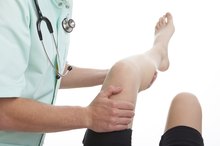Causes of Fever & Pain in the Leg
The simultaneous occurrence of fever and leg pain often points to the presence of an infectious or autoimmune disorder. Infections of the leg skin, joints or bones frequently cause the abrupt onset of fever and pain. Gradually evolving pain with intermittent fevers provokes suspicion for a chronic condition. Accurate diagnosis of the underlying cause of fever and leg pain, along with prompt treatment, minimizes the risk for complications.
If you are experiencing serious medical symptoms, seek emergency treatment immediately.
Cellulitis
Cellulitis is a bacterial infection of the deep skin layers. Streptococcal and staphylococcal bacteria most commonly cause cellulitis. Although cellulitis can occur anywhere, the legs remain the most frequent site of infection. Symptoms include tenderness, swelling, skin redness, fever and chills. Factors that increase susceptibility to the development of cellulitis include:
- diabetes
- obesity
- alcoholism
- a preexisting wound
- poor circulation
- a weakened immune system
- advancing age
Prompt antibiotic therapy helps prevent the spread of infection.
- Cellulitis is a bacterial infection of the deep skin layers.
- Although cellulitis can occur anywhere, the legs remain the most frequent site of infection.
Septic Arthritis
What Is the Difference Between Stasis Dermatitis & Cellulitis?
Learn More
Infection of the joint fluid defines septic arthritis. The immune system response to the infection causes inflammation and provokes symptoms including pain, swelling, tenderness and joint stiffness. Flu-like symptoms, chills and fever also occur in most people with septic arthritis. Most cases of septic arthritis involve a single joint, with the knee most commonly affected. The hips are another common site of septic arthritis. The disorder may occur at any age but most frequently strikes those older than age 60.
- Infection of the joint fluid defines septic arthritis.
- Most cases of septic arthritis involve a single joint, with the knee most commonly affected.
Osteomyelitis
Osteomyelitis is a bacterial or fungal bone infection 4. The disorder can occur at any age, but mostly frequently develops in early childhood or late adulthood. The most common sites for osteomyelitis include the spine, feet and the long bones of the arms and legs. Common symptoms include bone pain, fever, chills, and swelling and warmth over the infected bone. A limp may develop with osteomyelitis affecting a leg bone. Factors that increase the risk for osteomyelitis include diabetes, sickle cell disease, a weakened immune system, injection drug use and advancing age.
- Osteomyelitis is a bacterial or fungal bone infection 4.
- Factors that increase the risk for osteomyelitis include diabetes, sickle cell disease, a weakened immune system, injection drug use and advancing age.
Rheumatoid Arthritis
My Child Is Complaining of Pain in His Legs
Learn More
Rheumatoid arthritis is a chronic autoimmune disorder characterized by immune system attack on the joint tissues. The inflammatory response provoked by the immune system causes progressive deterioration of joint structure and function. Rheumatoid arthritis frequently affects the knee, hip and shoulder joints in addition to the joints of the feet and hands. Typical symptoms include joint swelling, pain and stiffness. Intermittent low-grade fevers often occur with rheumatoid arthritis.
- Rheumatoid arthritis is a chronic autoimmune disorder characterized by immune system attack on the joint tissues.
When To See a Doctor
Call your doctor right away if you develop a fever and leg pain. Seek immediate medical attention if you notice a spreading red rash, especially if accompanied by pain or swelling.
Related Articles
References
- Clinical Infectious Disease; David Schlossberg, M.D.
- Primer on the Rheumatic Diseases, 13th Edition; John H. Klippel, et al.
- Rosen's Emergency Medicine: Concepts and Clinical Practice, 8th Edition; John Marx, et al.
- Merck Manual Professional Version: Osteomyelitis
- Merck Manual Professional Version: Rheumatoid Arthritis
- Carek PJ, Dickerson LM, Sackier JM. Diagnosis and Management of Osteomyelitis. AAFP Home.
- Chen CE, Shih ST, Fu TH, et al. Hyperbaric oxygen therapy in the treatment of chronic refractory osteomyelitis: a preliminary report. Chang Gung Med J. 2003 Feb;26(2):114-21.
- Cleveland Clinic. Osteomyelitis.
- Genetic and Rare Diseases Information Center. Osteomyelitis.
- Medline Plus. Osteomyelitis.
- Olson ME, Horswill AR. Staphylococcus aureus Osteomyelitis: Bad to the Bone. Cell Host Microbe. 2013 Jun 12; 13(6): 629–631. doi:10.1016/j.chom.2013.05.015
- Patel RA, Wilson, RF, Palmer RM. The effect of smoking on bone healing: A systematic review. Bone Joint Res. 2013 Jun; 2(6): 102–111. doi:10.1302/2046-3758.26.2000142
- Schmitt S. Merck Manuals. Osteomyelitis.
- Skin Cancer Foundation. Squamous Cell Carcinoma.
Writer Bio
Dr. Tina M. St. John owns and operates a health communications and consulting firm. She is also an accomplished medical writer and editor, and was formerly a senior medical officer with the U.S. Centers for Disease Control and Prevention. St. John holds an M.D. from Emory University School of Medicine.








